
The Bottom Line
Introduction, Specifications, Pricing & Availability
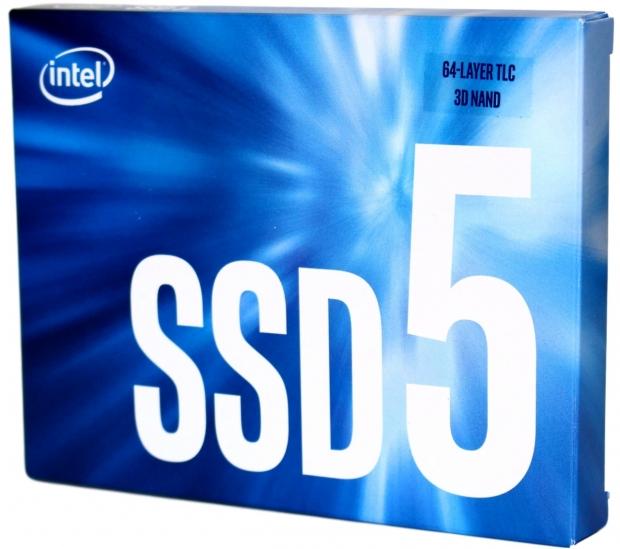
This year is going to be all about 64-layer 3D TLC flash. Intel, Micron, Samsung, SanDisk, and Toshiba are all set to start shipping 64-layer 3D flash products. 64-layer 3D TLC flash promises higher density, better performance, lower power consumption and lower cost per gigabyte than current 32 and 48-layer 3D flash. Intel's 64-layer 256Gbit 3-bit 3D flash is again built on proven floating gate architecture and manufacturing process. Floating gate technology gives Intel 3D flash the industry's highest areal density available today and CMOS under array keeps the footprint compact.
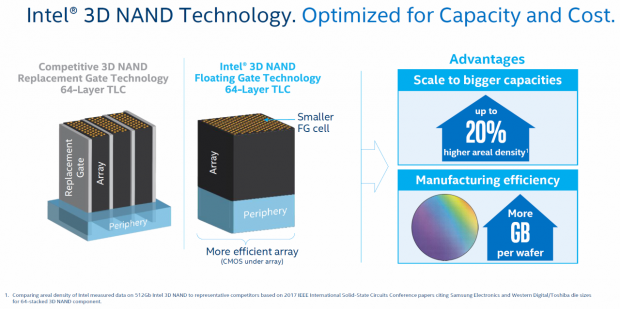
Intel's SSD 5-Series 545s SATA III SSD is the first 64-layer 3D TLC SSD that has completed our testing regimen, and we are very impressed.
Intel has again teamed up with Silicon Motion for the SSD 545s. The SSD 545s, like the 540s that it is replacing, is powered by a 4-channel Silicon Motion controller. The SSD 540s is powered by a Silicon Motion SM2258 controller; a controller that we are particularly fond of, and we believe that the SM2259 that powers the SSD 5 545s is based on the SM2258 with some minor modifications. As Intel has done many times in the past, they are writing their own custom firmware to power the SMI 2259 controller. This gives Intel the flexibility to tune the SDD 5 545s' performance to their liking.
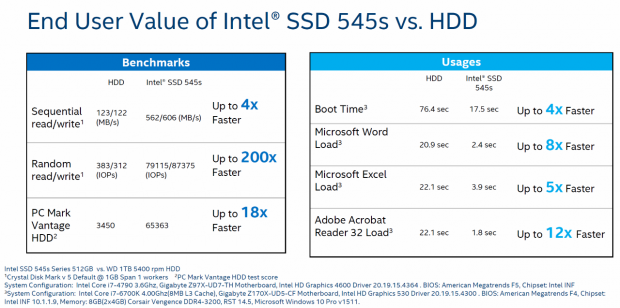
Intel is marketing their new SSD 5 545s as an affordable HDD replacement that delivers superior performance, leading-edge reliability, lower power consumption and broad compatibility - spend less time waiting & more time doing. Intel has the industry's most rigorous testing standards and is backing the SSD 5 545s with a robust 5-year warranty. To make transitioning to a super-fast Intel SSD 5 545s easy for beginners and experienced users alike, the SSD 5 545s is compatible with Intel's free and easy to use Intel Data Migration Software.
Let's take a quick look at the SSD 5 545s 512GB factory specifications and then dive deep into benchmarking Intel's second-generation 3D TLC flash.
Factory Specifications
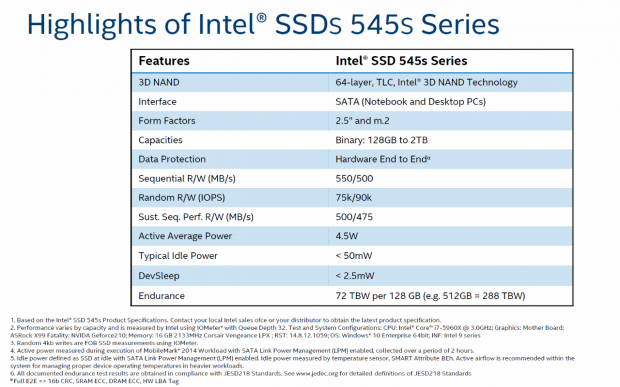
Intel SSD 5-Series 545s 512GB SATA III SSD:
- Sequential Read: up to 550 MB/s
- Sequential Write: up to 500 MB/s
- Max 4K Random Read Speed: up to 75,000 IOPS
- Max 4K Random Write Speed: up to 85,000 IOPS
- Endurance: 288TB
- MTBF: 1.6 Million Hours
- Warranty: 5-Year Limited Warranty
- Avg. Active Power Consumption: 4.5W
- Idle Active Power Consumption: <50mW
- Hardware-level End-to-End Data Path Protection
- ECC
- SMART
- TRIM
- Garbage Collection
- Software: SSD Toolbox, Migration Software
MSRP: $179.00 Availability: Available at Newegg as you read this.
The SSD 5 545s 512GB pairs Silicon Motion's SM2259 controller with Intel 256Gbit 64-layer 3D TLC (Triple-Level-Cell) flash in BGA flash packages. BGA packaged flash is the good stuff, it is capable of higher bus speeds than TSOP packaged flash. Table caching is handled by a single Sk Hynix LPDDR3 DRAM cache package with a capacity of 1MB to 1GB DRAM to NAND ratio.
Drive Details
Intel SSD 5 545s 512GB SATA III SSD
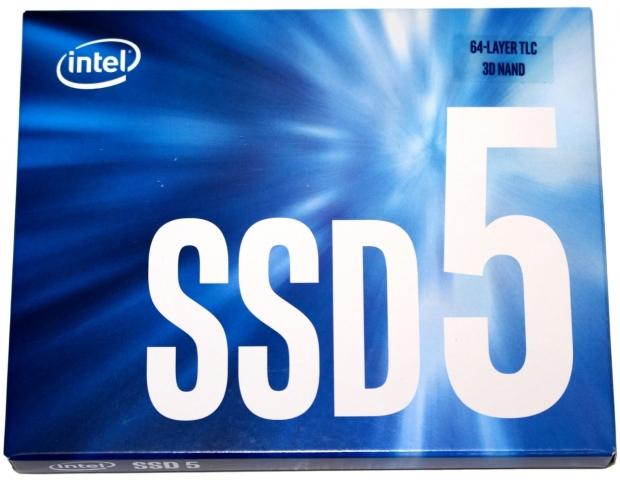
The blue and white themed packaging advertises that the 545s is part of Intel's SSD 5 series. There is a little sticker on the upper right corner that advertises the drive's 64-layer TLC 3d NAND array.
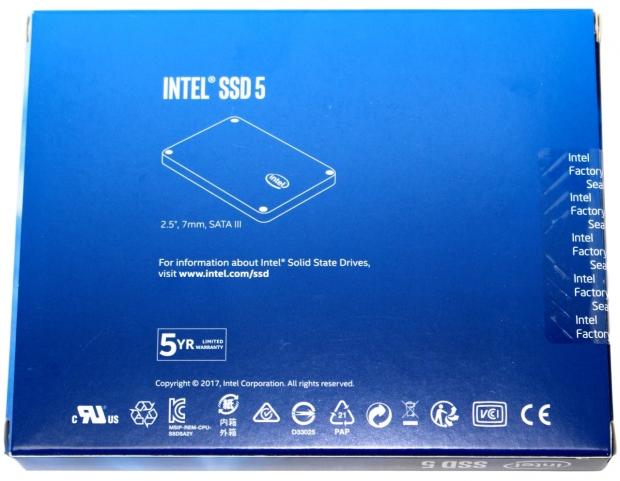
The rear of the packaging lists the drive's form factor and five-year limited warranty. Actual retail packaging will list performance details that are absent on our sample's packaging.
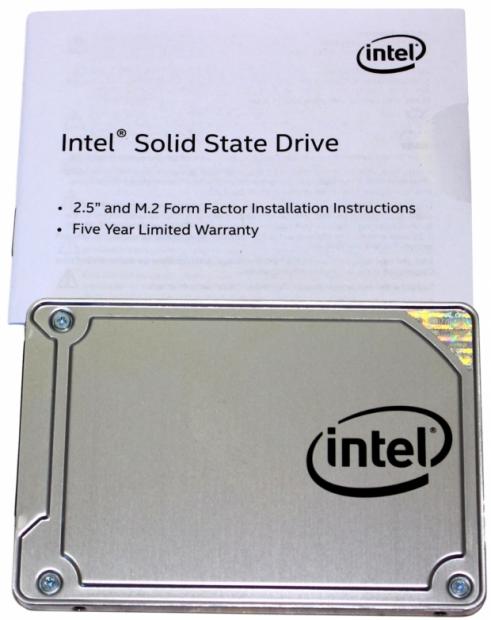
Inside of the packaging, the drive is encased in a sealed static resistant envelope (not shown). Intel also includes a printed warranty and installation guide. The top of the enclosure is a familiar stamped sheet aluminum piece fastened with four screws.
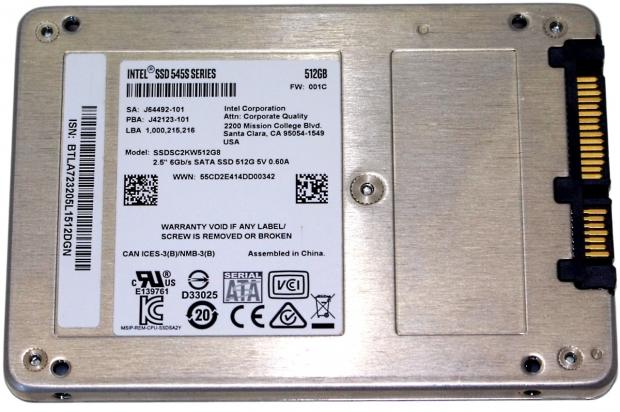
The bottom and sides of the enclosure are formed from sheet aluminum. This is a break from the usual heavy cast aluminum piece used on previous Intel SSDs. There is a manufacturer's label listing the particulars of the drive.
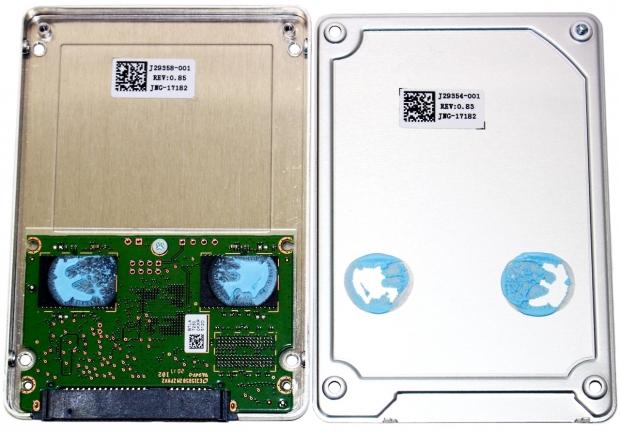
Popping the enclosure open reveals the back side of a half-length PCB. This side of the PCB houses two of the drives four 128GB 64-layer 3d TLC flash packages. There is also an empty landing pad for an additional DRAM cache package for future larger capacities. Thermal material is present on the flash packages.
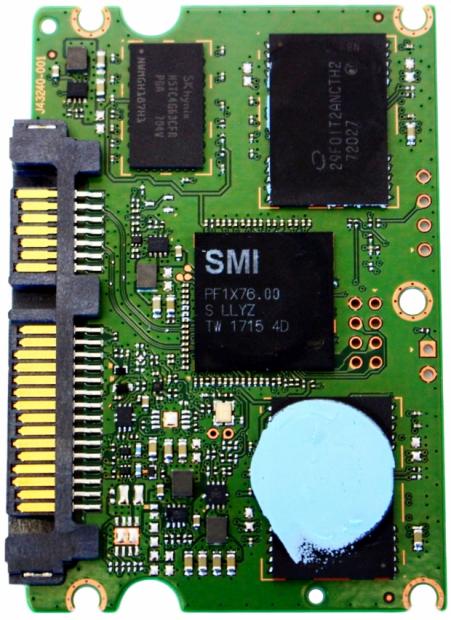
We removed the thermal goop from the drives SMI SM2259 4-channel controller and one of the drives four 128GB 64-layer 3D TLC flash packages so we could view them. This side of the PCB houses the drives controller, two flash packages, and an Sk Hynix 512MB DDR3 DRAM package.
Test System Setup and Properties
Jon's Consumer SSD Review Test System Specifications
- Motherboard: ASRock Extreme9 Z97 - Buy from Amazon
- CPU: Intel Core i7 4790K @ 4.8GHz - Buy from Amazon / Read our review
- Cooler: Swiftech H2O-320 Edge - Buy from Amazon / Read our review
- Memory: Corsair Dominator DDR3 32GB 2400MHz - Buy from Amazon
- Video Card: Onboard Video
- Case: IN WIN X-Frame - Buy from Amazon / Read our review
- Power Supply: Seasonic Platinum 1000 Watt Modular - Buy from Amazon / Read our review
- OS: Microsoft Windows 10 Professional 64-bit - Buy from Amazon
- Drivers: Intel RAID option ROM version 13.0.0.2075 and Intel RST driver version 14.8.0.1042
We would like to thank ASRock, Crucial, Intel, Corsair, RamCity, IN WIN, and Seasonic for making our test system possible.
Drive Properties
Intel SSD 5 545s 512GB OS Disk 75% Full
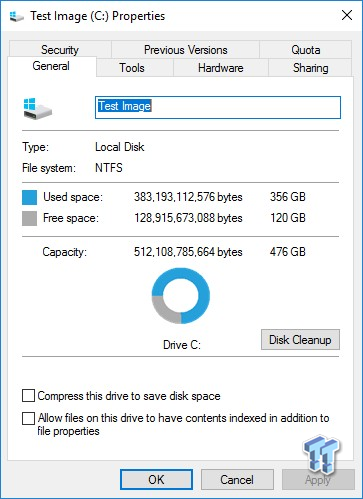
The majority of our testing is performed with our test drive as our boot volume. Our boot volume is 75% full for all OS Disk "C" drive testing to replicate a typical consumer OS volume implementation. We feel that most of you will be utilizing your SSDs for your boot volume and that presenting you with results from an OS volume is more relevant than presenting you with empty secondary volume results.
System settings: Cstates and Speed stepping are both disabled in our systems BIOS. Windows High-Performance power plan is enabled. Windows write caching is enabled, and Windows buffer flushing is disabled. We are utilizing Windows 10 Pro 64-bit OS for all of our testing except for our MOP (Maxed-Out Performance) benchmarks where we switch to Windows Server 2008 R2 64-bit. Empty Windows 10 benchmark screenshots will also be shown on our MOP page.
Synthetic Benchmarks - ATTO & Anvil's
ATTO
Version and / or Patch Used: 2.47
ATTO is a timeless benchmark used to provide manufacturers with data used for marketing storage products. With ATTO, we are looking at maximum sequential performance with compressible data as well as the performance curve.
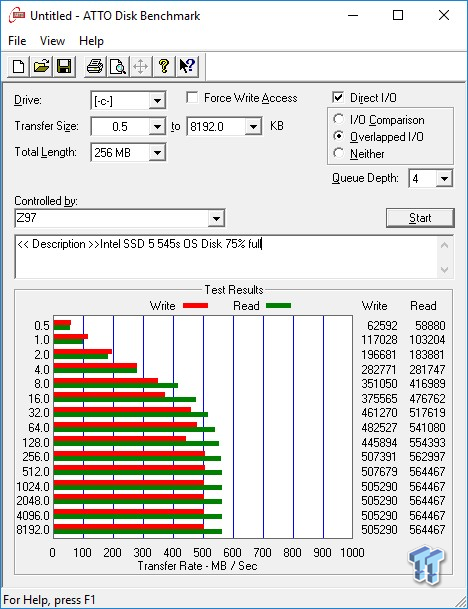
Compressible sequential read/write transfers max out at 564/507 MB/s. Both figures exceed Intel's factory specs. Keep in mind this is our OS volume, and it is filled to 75% of its total capacity. Maximum sequential performance is achieved at 512KB transfers.
Sequential Write
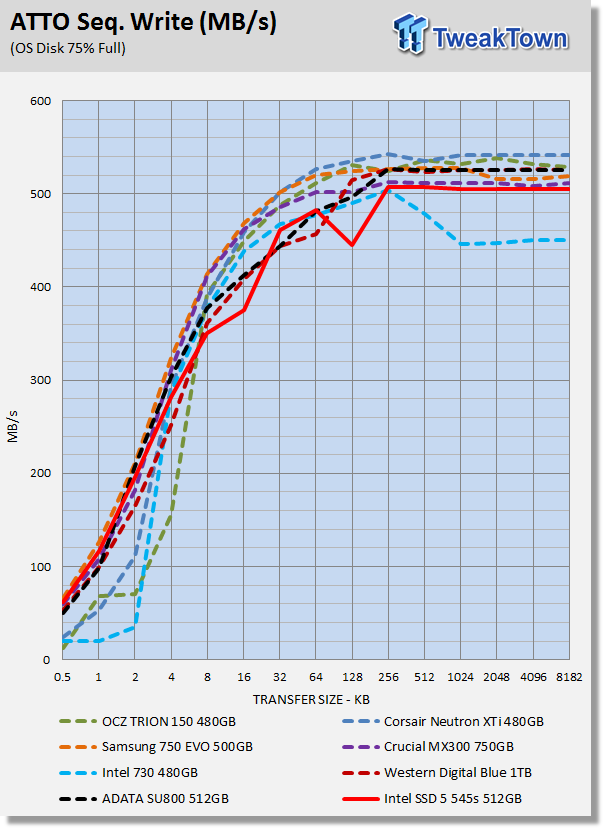
We decided to toss Intel's 730 480GB into the fray. The 480GB 730 series SSD is no longer being sold, but to this day, it is one of the fastest SATA SSDs ever made. This will allow us to gauge the progression of Intel's SATA TLC SSDs in comparison to their fastest MLC SATA model. The SSD 5 545s delivers the goods when the file size is small. We see a couple of small dips in the performance curve, but nothing that causes concern.
Sequential Read
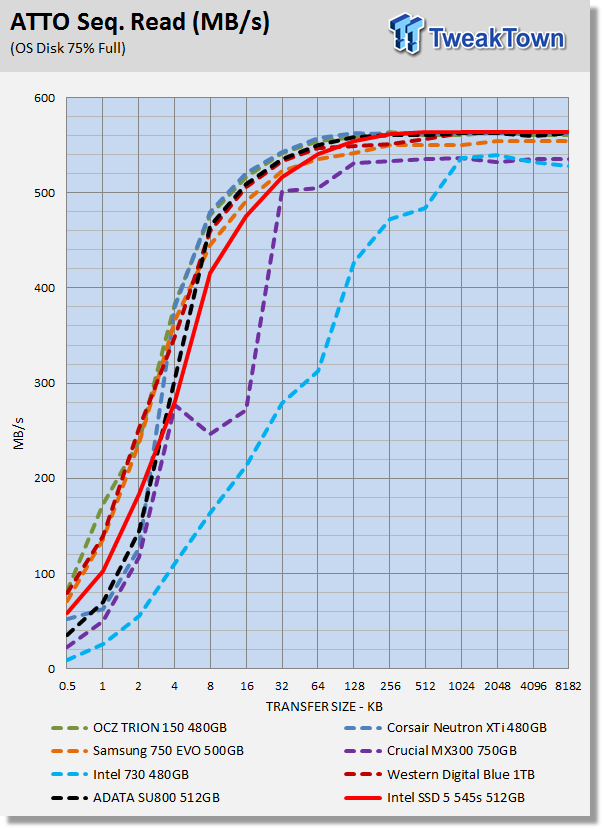
We are looking for a nice smooth performance curve and good small-file performance. The SSD 5 545s gives us exactly what we are looking for. Great small-file performance and class-leading performance on the big end. We can see that sequential performance of Intel SSDs have progressed greatly over the years when we compare the 545s to the 730. The drive with the closest hardware configuration to the 545s is the SU800. The SU800 employs an SM2258 controller and first generation IMFT 32-layer 3D flash. The drives trade blows, but we give the win to the 545s because it has better small file performance.
Anvil Storage Utilities
Version and / or Patch Used: 1.1.0
Anvil's Storage Utilities is a storage benchmark designed to measure the storage performance of SSDs. The Standard Storage Benchmark performs a series of tests; you can run a full test or just the read or write test, or you can run a single test, i.e. 4K QD16. With Anvil's, we are focused on the total score.
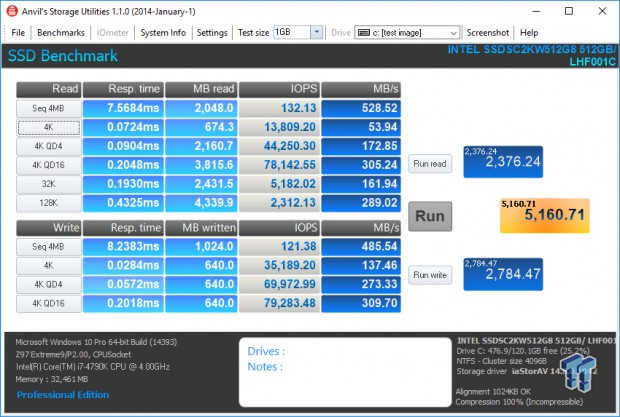
Scoring
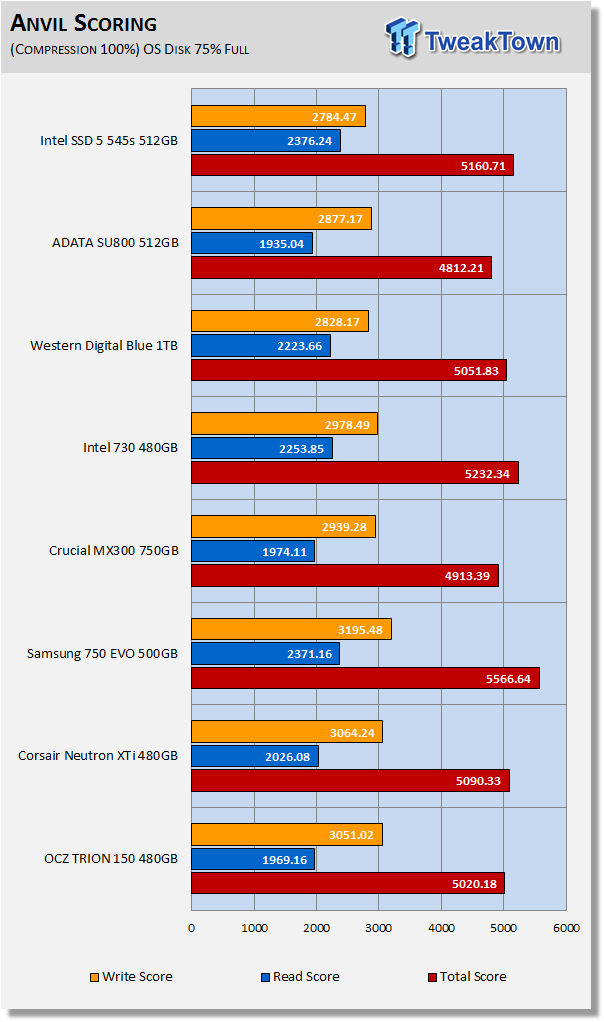
Anvil's scoring typically provides us with a good indication of a drive's overall synthetic performance. Whenever we get a score of over 5,000, we take notice. The SSD 5 545s is the first Intel SATA SSD to exceed this milestone since the 480GB Intel 730. We consider 4K QD1 random read performance to be one of the best indicators of how well a drive will perform as an OS disk.
We consider 10K at QD1 a milestone that very few SSDs are capable of delivering. Only the best can do it, and SSD 5 545s smashes right through the 10K ceiling delivering an astounding 13,800 random read IOPS at QD1. Of course, this is just SLC assisted burst speed, but typical consumer workloads are bursty in nature, so it does reflect the typical user experience.
Now, let's focus in on the most important score the read score. Here we find the Intel SSD 5 545s delivering a big win. Much to our surprise, it delivers a better-read score than the mighty Samsung 750 EVO 500GB. We are beginning to see that Intel is focusing on random read performance which has been very much lacking with first generation 32-layer IMFT 3D flash. Compare the read score of the SU800 to the 545s to see what we mean.
(Anvil) Read IOPS through Queue Depth Scale
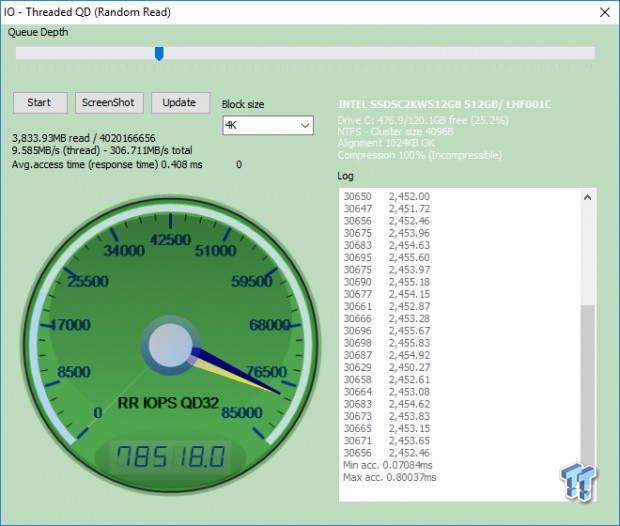
We are exceeding factory max random read specs (75K IOPS at QD32) even when our drive has a partition on it, and it is 75% full.
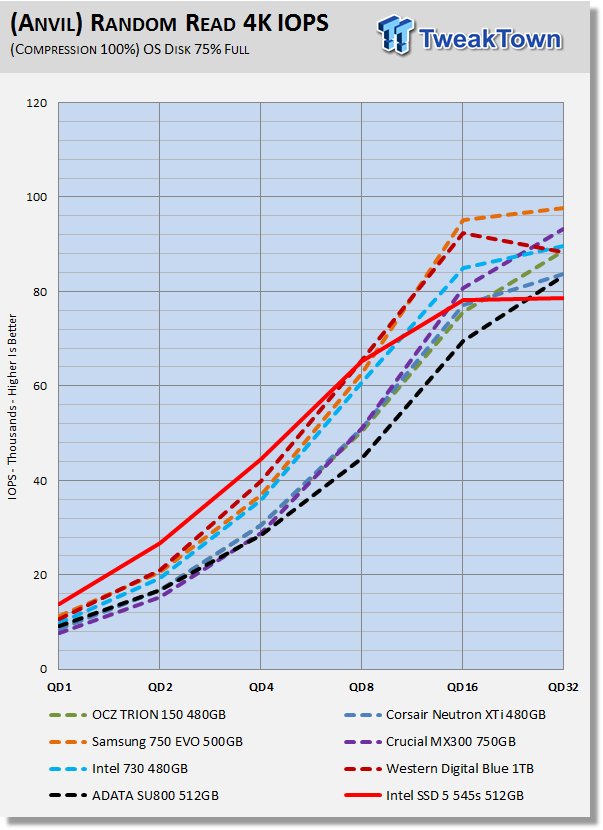
The 545s delivers the goods where it matters most, low queue depths. This is the best low queue random read performance we've ever seen from any SATA SSD to date when running Anvil's. We didn't include the 850 EVO in our test pool but can confirm that the SSD 5 545s is delivering better random read performance at low queue depths than the 850 EVO and 850 Pro. Gen 2 IMFT 64-Layer flash is looking very, very good.
(Anvil) Write IOPS through Queue Scale
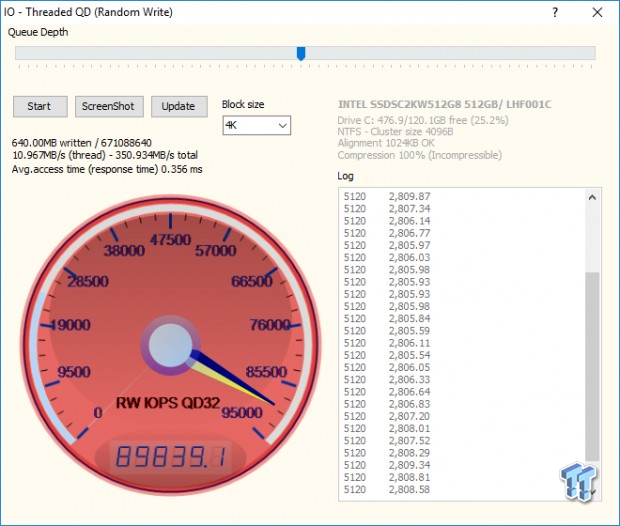
We are exceeding factory max random read specs (85K IOPS at QD32) even when our drive has a partition on it, and it is 75% full.
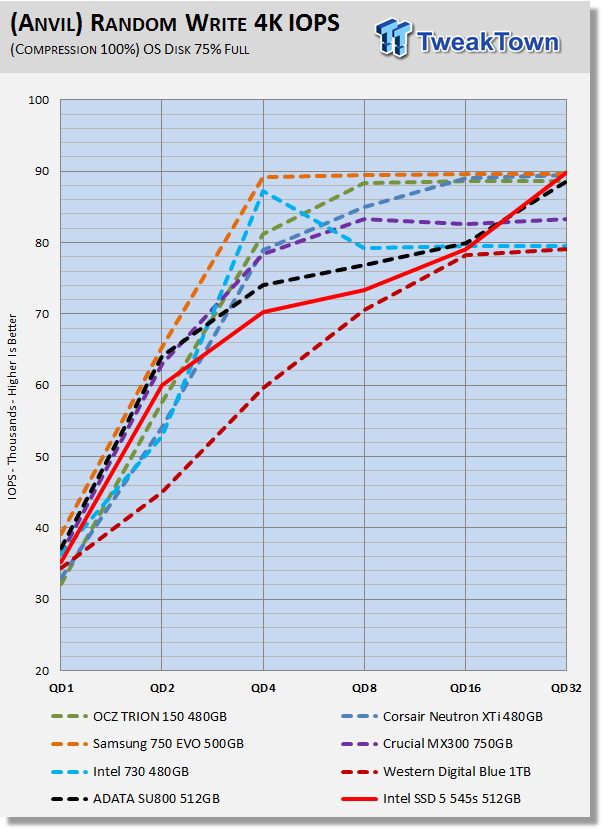
The SSD 5 545s runs in the middle of the pack when writing random data at low queue depths. This is fine by us because this is more than offset by the 545s' superior random read performance. Read performance is more important than write performance, and we are extremely happy to see that Gen2 IMFT 3D flash is now more balanced. With Gen1 IMFT we got lousy read performance even with 256Gbit 3D MLC.
Synthetic Benchmarks - CDM & AS SSD
CrystalDiskMark
Version and / or Patch Used: 3.0 Technical Preview
CrystalDiskMark is disk benchmark software that allows us to benchmark 4K and 4K queue depths with accuracy. Note: Crystal Disk Mark 3.0 Technical Preview was used for these tests since it offers the ability to measure native command queuing at QD4. With this version of CDM, we are focused on 4K random performance at QD1 and QD4.
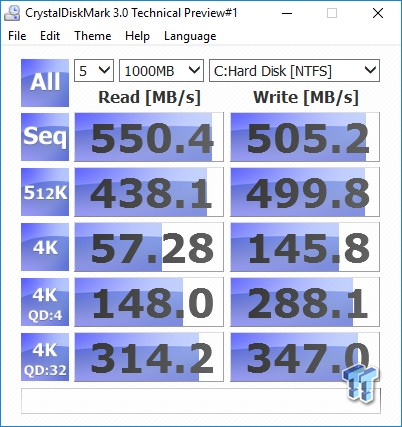
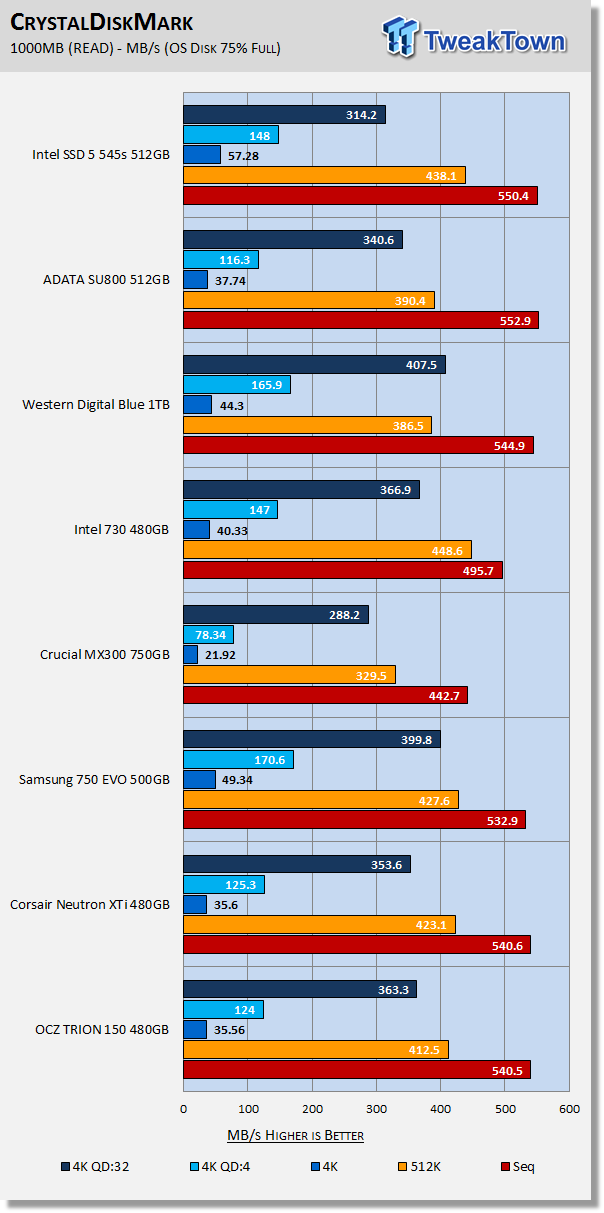
Focusing in on 4K QD1 and 4K QD4, we are getting very strong performance from the SSD 5 545s, WD Blue and 750 EVO. All three are delivering elite performance. Because QD1 performance is more important than QD4, we are giving the win to the 545s because random read performance at QD1 is more important than at QD4.
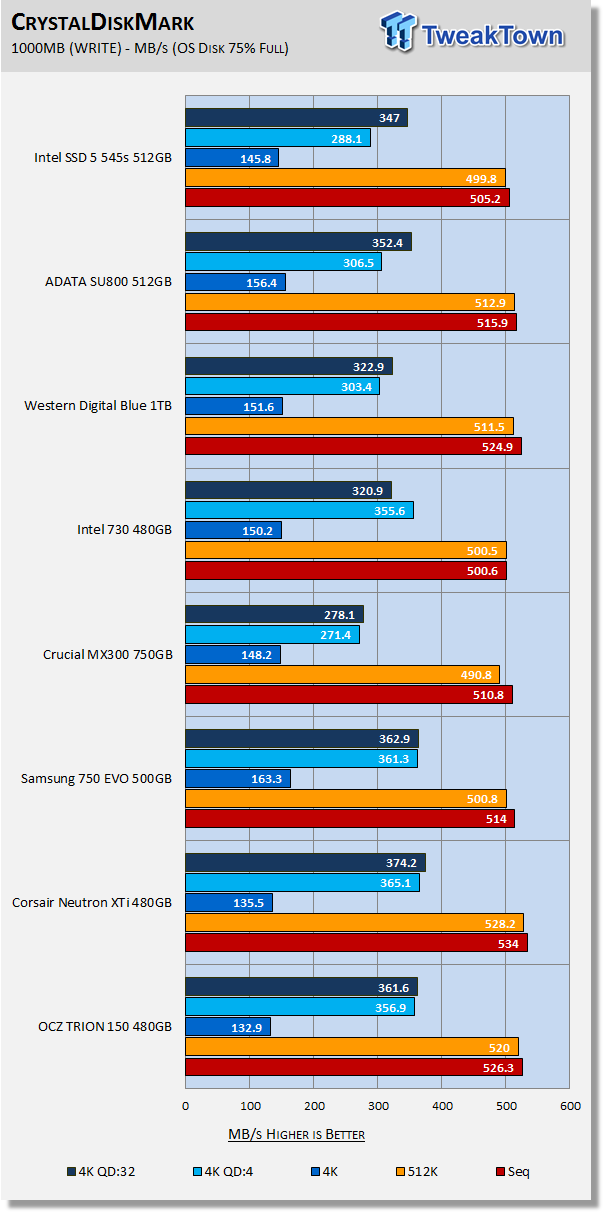
The Intel SSD 545s is a read centric SSD, so write performance is a secondary consideration as this chart shows. Even so, the write performance we are getting is still quite good. This is what we want to see from a good OS disk. We want it to deliver excellent read performance and still deliver average write performance.
AS SSD
Version and / or Patch Used: 1.8.5611.39791
AS SSD determines the performance of SSDs. The tool contains four synthetic as well as three practice tests. The synthetic tests are to determine the sequential and random read and write performance of the SSD. We focus on the total score when evaluating AS SSD.
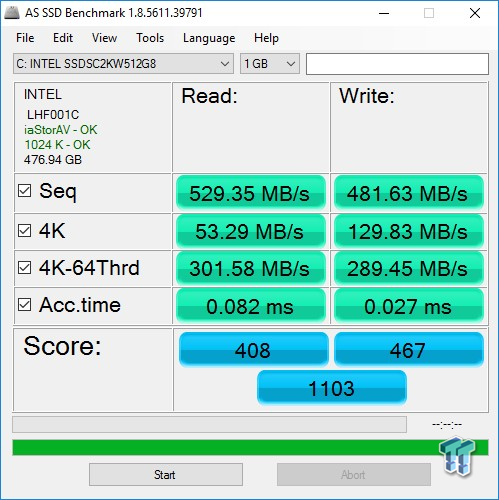
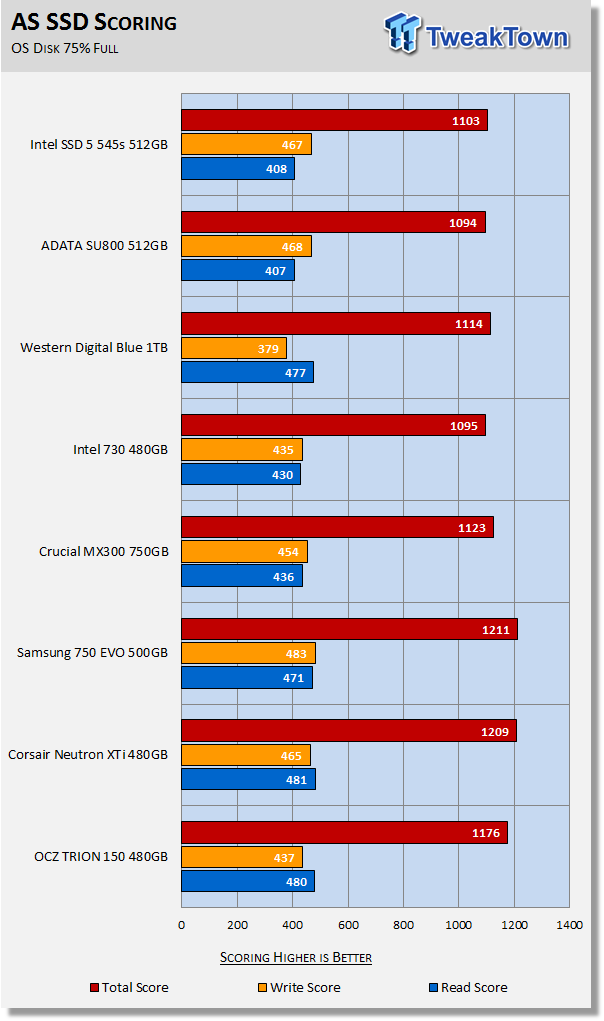
AS SSD is a demanding test. With AS SSD we are looking for a minimum score of 1000 from a TLC SSD. A score of 1100 is excellent. It is better than the powerful 730 Series can get. The reason the SSD 5 545s doesn't score higher than some of the less powerful SSDs in our test pool is simply because AS SSD scoring is heavily weighted toward high queue depth performance.
Benchmarks (OS) - Vantage, PCMark 7, PCMark 8 & SYSmark 2014 SE
Consumer Workloads
We categorize these tests as indicative of a moderate workload environment.
PCMark Vantage - Hard Disk Tests
Version and / or Patch Used: 1.2.0.0
The reason we like PCMark Vantage is because the recorded traces are played back without system stops. What we see is the raw performance of the drive. This allows us to see a marked difference between scoring that other trace-based benchmarks do not exhibit. An example of a marked difference in scoring on the same drive would be empty vs. filled vs. steady state.
We run Vantage three ways. The first run is with the OS drive 75% full to simulate a lightly used OS volume filled with data to an amount we feel is common for most users. The second run is with the OS volume written into a "Steady State" utilizing SNIA's guidelines. Steady state testing simulates a drive's performance similar to that of a drive that been subjected to consumer workloads for extensive amounts of time. The third run is a Vantage HDD test with the test drive attached as an empty, lightly used secondary device.
OS Volume 75% Full - Lightly Used
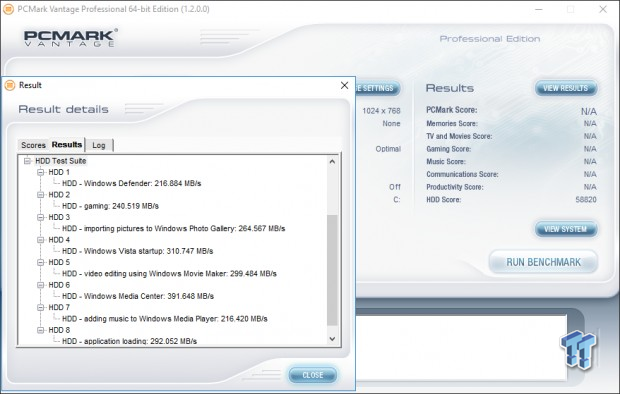
OS Volume 75% Full - Steady State
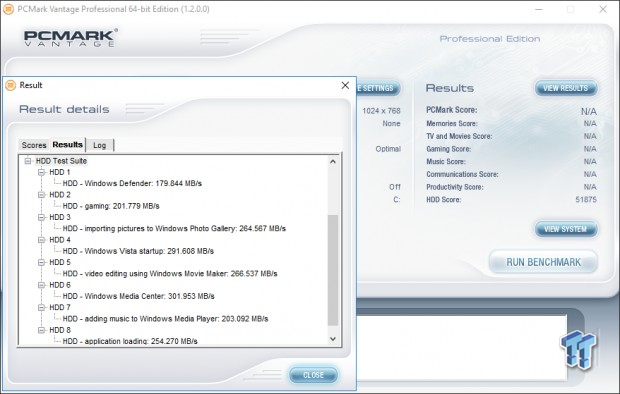
Secondary Volume Empty - FOB
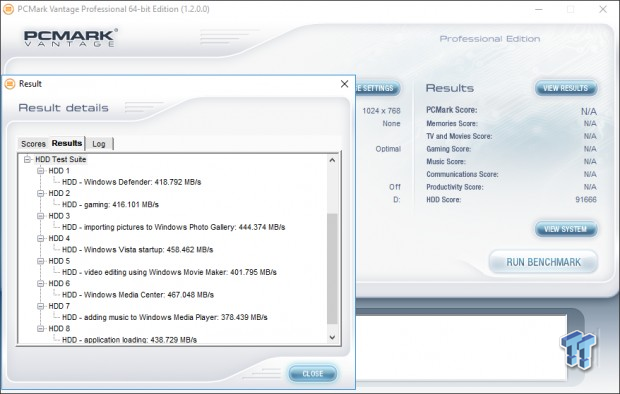
There's a big difference between an empty drive, one that's 75% full/used, and one that's in a steady state.
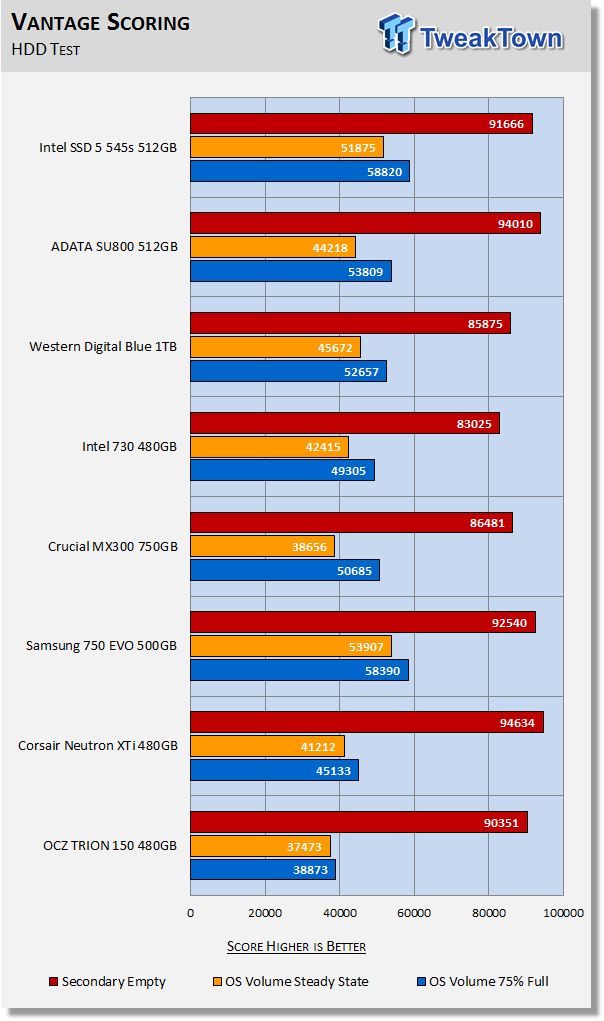
The important scores to pay attention to are "OS Volume Steady State" and "OS Volume 75% full." These two categories are most important because they are indicative of typical of consumer user states. When a drive is in a steady state, it means garbage collection is running at the same time it's reading/writing. This is exactly why we focus on steady state performance.
At 75% full, the Intel SSD 5 545s is the most powerful SSD in our test pool. Killer workload performance is what we are looking for more than anything else, and the SSD 5 545s is delivering boatloads of it. Samsung's 750 EVO 500GB manages to eek out a victory in a steady-state, but other than that, the 545s eviscerates the competing drives in our test pool.
PCMark 7 - System Storage
Version and / or Patch Used: 1.4.0
We will look to Raw System Storage scoring for evaluation because it's done without system stops and, therefore, allows us to see significant scoring differences between drives.
OS Volume 75% Full - Lightly Used
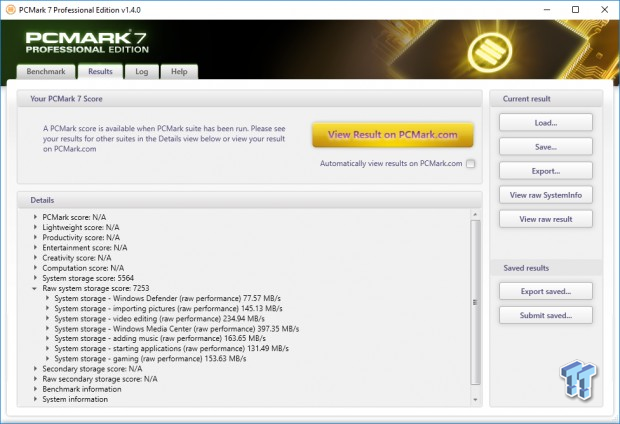
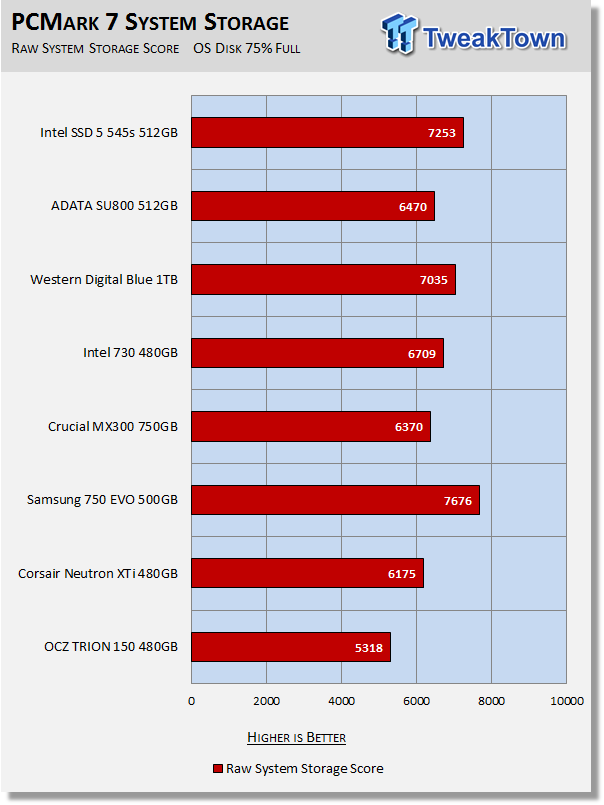
Whenever a SATA SSD scores 7K or above with PCMark 7, it is in an elite class. The SSD 5 545s again shows that it is a consumer workload powerhouse. Samsung's 750 EVO wins, but once again the 545s delivers a roundhouse to the other competing SSDs in our test pool. Finally, we are seeing someone pressing Samsung for supremacy. The 545s is delivering better performance than Intel's 480GB 730.
PCMark 8 - Storage Bandwidth
Version and / or Patch Used: 2.4.304
We use PCMark 8 Storage benchmark to test the performance of SSDs, HDDs, and hybrid drives with traces recorded from Adobe Creative Suite, Microsoft Office, and a selection of popular games. You can test the system drive or any other recognized storage device, including local external drives. Unlike synthetic storage tests, the PCMark 8 Storage benchmark highlights real-world performance differences between storage devices. We focus on the total storage bandwidth when evaluating PCMark 8 results.
OS Volume 75% Full - Lightly Used
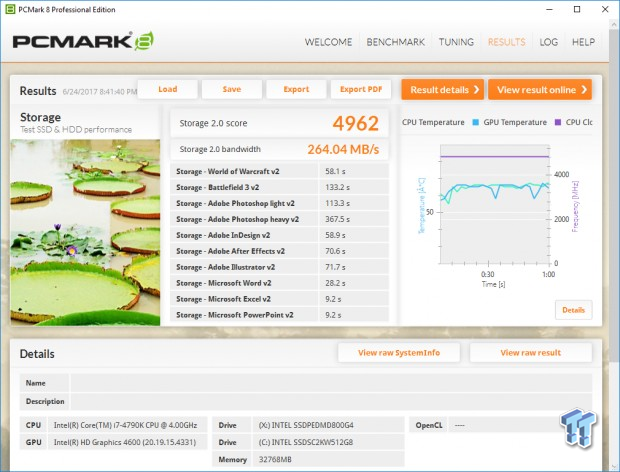
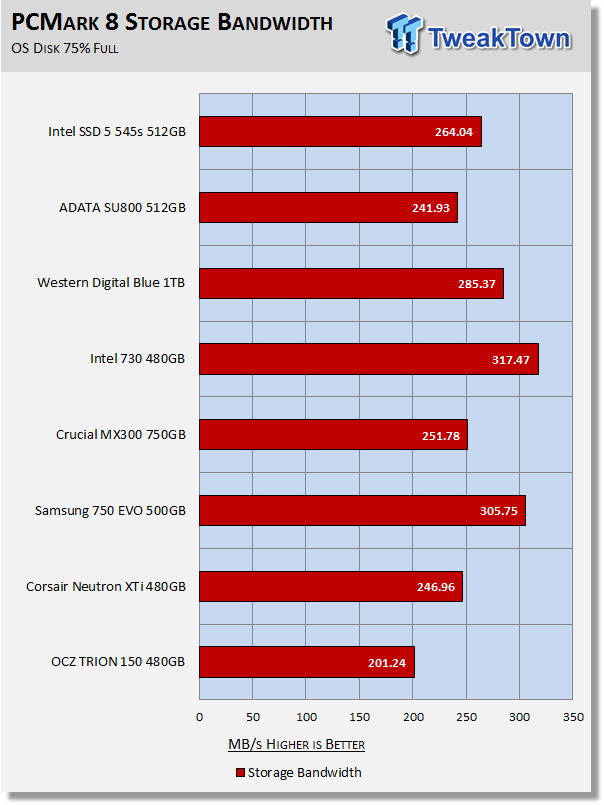
PCMark 8 is the most intensive moderate workload simulation we run. With respect to moderate workloads, this test is what we consider the best indicator of a drive's overall performance. PCMark 8 hits a drive pretty hard. It also preconditions the empty space on the drive. This means that overprovisioning plays a big role in terms of scoring as does capacity. We believe that the WD Blue scores higher than the SSD 5 545s because it has double the capacity. We believe that the other drives that outscore the 545s are benefitting from overprovisioning. Whatever the case may be, the 545s delivers excellent PCMark 8 performance even though it isn't the best out there.
BAPCo SYSmark 2014 SE System Performance
Version and / or Patch Used: 2.0.0.70
SYSmark 2014 SE is considered the gold standard for testing system performance because it is an application based benchmark. This test gives us the ultimate in real-world results because it utilizes actual applications running on the system, instead of playing back recorded traces. If you want to know what kind of impact a particular SSD will have on your system's overall performance; this test will show you.
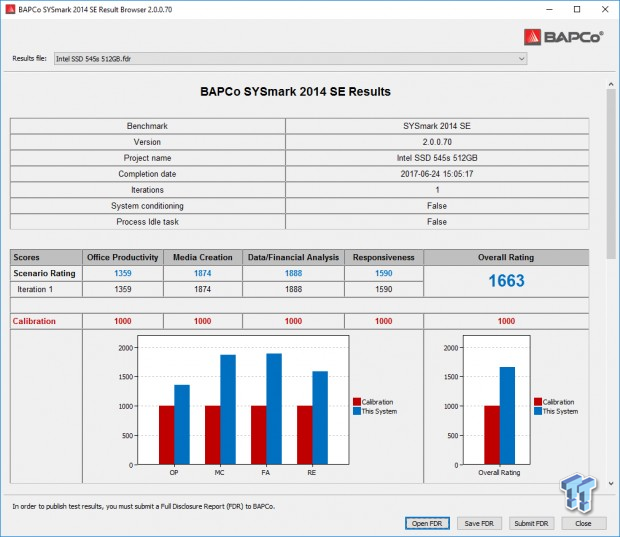
Disk performance has the greatest impact on the Responsiveness Score, so that is what we will focus on.
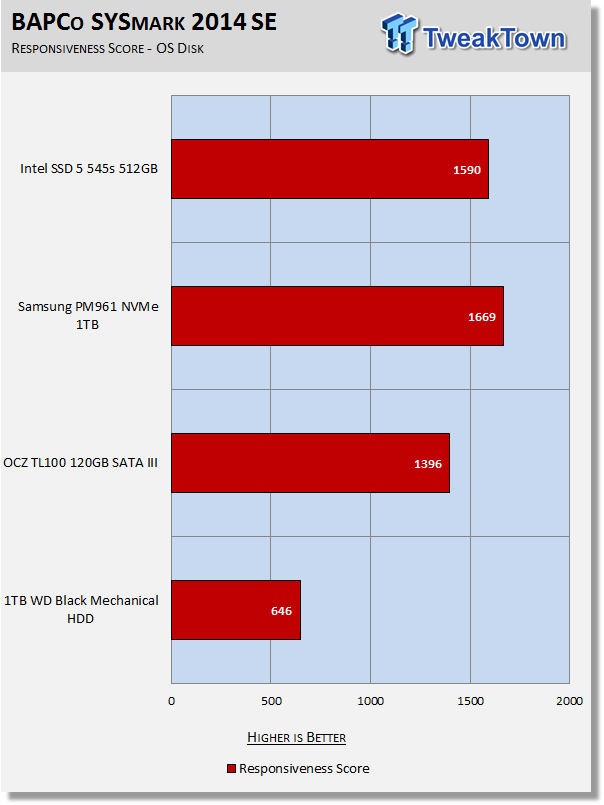
Our systems are much more powerful than the calibration system (1000-point baseline) used by BAPCo, so we ran an OCZ TL100 120GB SATA III SSD to establish a comparison point relative to our test systems. We will be running this test going forward, and we will add drives to our chart as we test them.
It is important to keep in mind that with SYSmark 2014 SE a few points are a big deal when comparing one drive to another on the same platform.
We don't have very many SSDs on our chart yet, but it looks like the 545s is very responsive. 200 points better than a low-end SSD and 79 points less than a high-end NVMe SSD.
Note: we are replacing our PCMark 8 Extended testing with SYSmark because we believe SYSmark is much more relevant for consumer SSD testing.
Benchmarks (Secondary) - IOPS, Response & Transfers
Iometer - Maximum IOPS
Version and / or Patch Used: Iometer 2014
We use Iometer to measure high queue depth performance. (No Partition)
Max IOPS Read
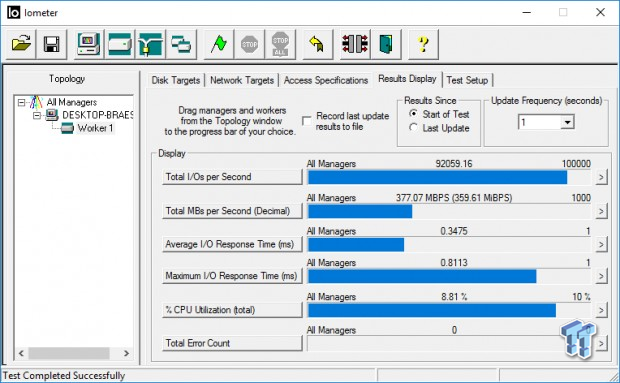
Max IOPS Write
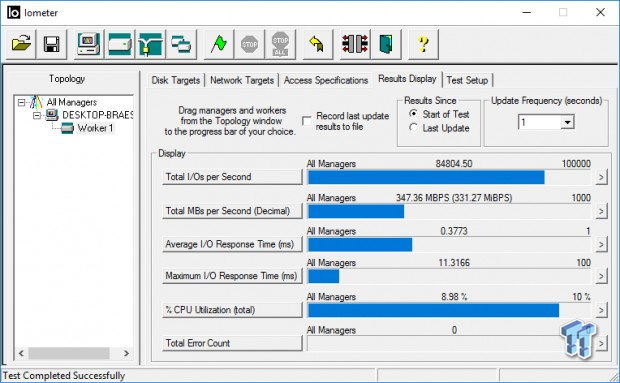
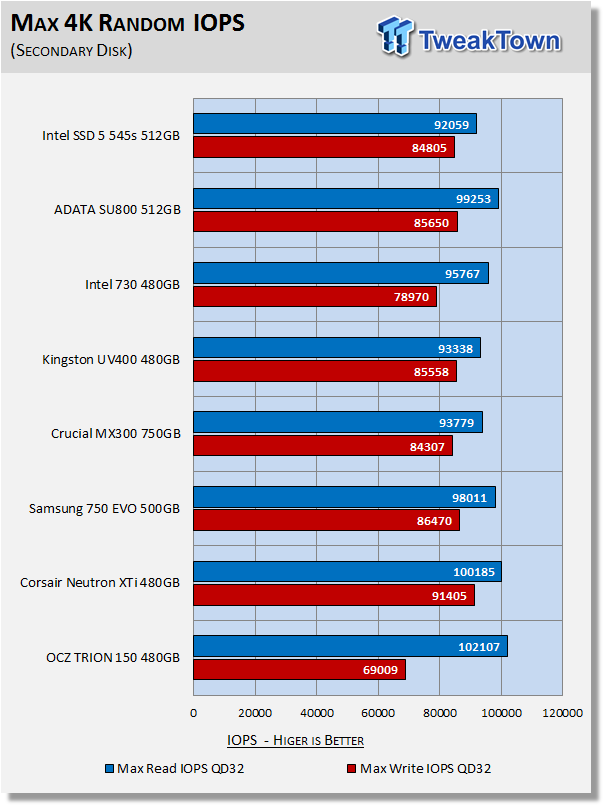
We are getting 17K more random read IOPS than the factory spec of 75K IOPS at QD32. We are close enough to hitting Intel's factory spec of 85K to call it 85K.
Iometer - Disk Response
Version and / or Patch Used: Iometer 2014
We use Iometer to measure disk response times. Disk response times are measured at an industry accepted standard of 4K QD1 for both write and read. Each test runs twice for 30 seconds consecutively, with a 5-second ramp-up before each test. We partition the drive/array as a secondary device for this testing.
Avg. Write Response
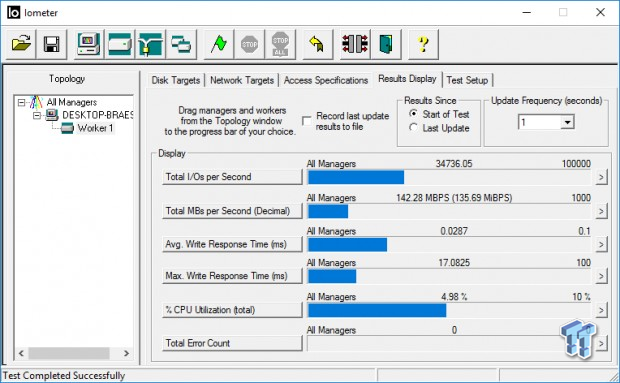
Avg. Read Response
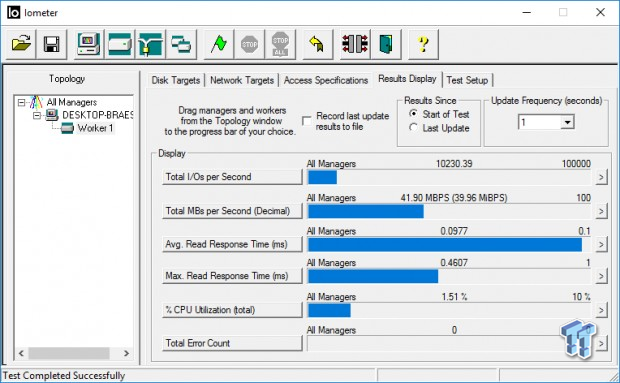
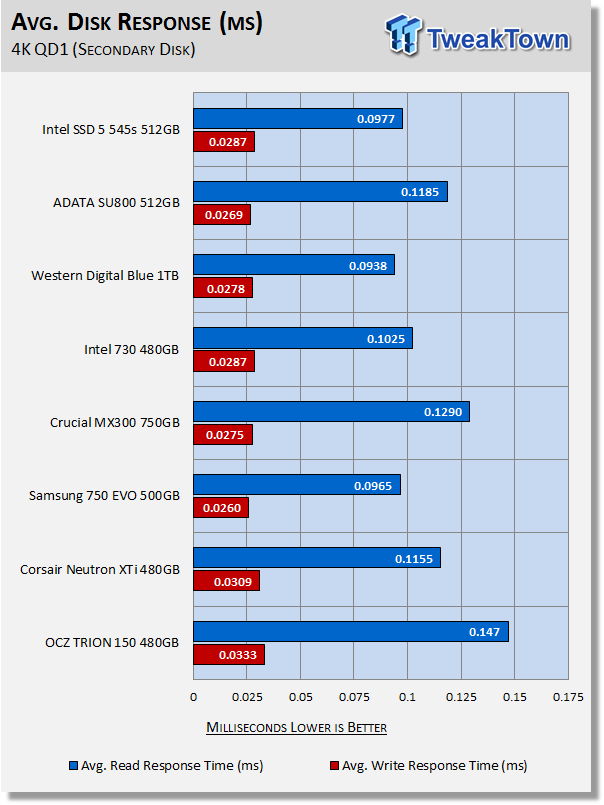
This testing bypasses the drives SLC cache, which is why the read response isn't better. It is still very good especially when we compare it with the SU8000 which has a somewhat similar hardware configuration.
DiskBench - Directory Copy
Version and / or Patch Used: 2.6.2.0
We use DiskBench to time a 28.6GB block (9,882 files in 1,247 folders) composed primarily of incompressible sequential and random data as it's transferred from our DC P3700 PCIe NVME SSD to our test drive. We then read from a 6GB zip file that's part of our 28.6GB data block to determine the test drive's read transfer rate. Our system is restarted prior to the read test to clear any cached data, ensuring an accurate test result.
Write Transfer Rate
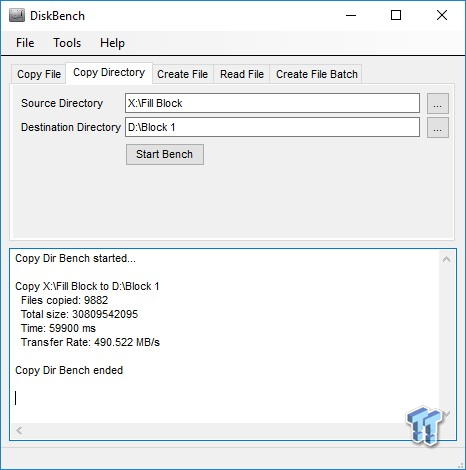
Read Transfer Rate
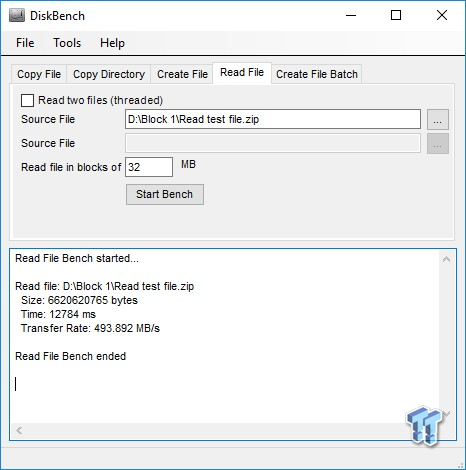
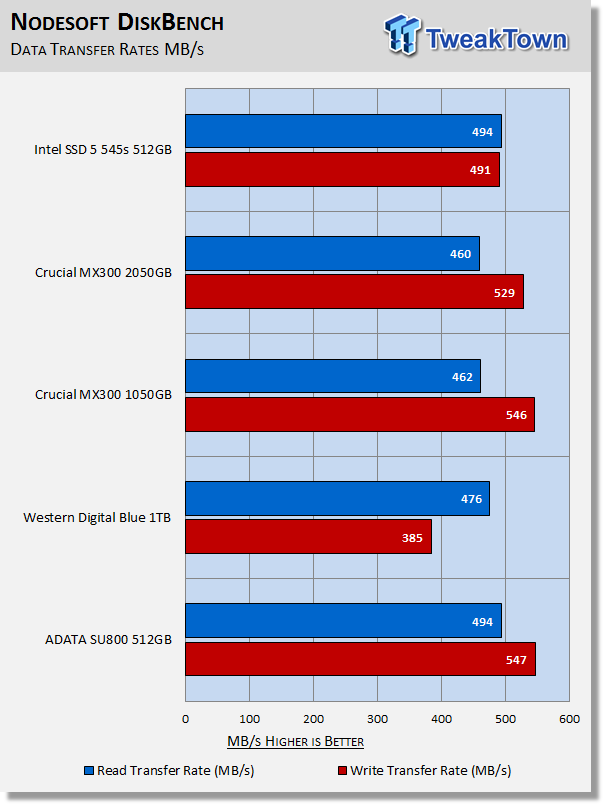
When testing write transfer rates, we have a rule of thumb. If any SSD cannot achieve 200MB/s with our write transfer test, that SSD will not receive a TweakTown recommendation. There are many TLC SSDs that do not pass our minimum, but we didn't include those on our chart. Additionally, we recently updated to Windows 10 Anniversary Edition and with that update, sustained write performance greatly increased. This means our previous transfer tests cannot be compared with those run on the newer version on Windows 10. This is the reason we only have a few drives on our chart.
The SSD 5 545s passes with flying colors. We believe the SU800 and MX300 have better write transfer rates due to the built-in OP that is inherent to 384Gbit flash. The 545s displays a nice balance in read/write transfer rates.
Benchmarks - 70/30 Mixed Workload & Write
70/30 Mixed Workload Test (Sledgehammer)
Version and / or Patch Used: Iometer 2014
Heavy Workload Model
This test hammers a drive so hard we've dubbed it "Sledgehammer." Our 70/30 Mixed Workload test is designed to simulate a heavy-duty enthusiast/workstation steady-state environment. We feel that a mix of 70% read/30% write, full random 4K transfers best represents this type of user environment. Our test allows us to see the drive enter into and reach a steady state as the test progresses.
Phase one of the test preconditions the drive for 1 hour with 128K sequential writes at QD32. Phase two of the test runs a 70% read/30% write at QD32, full random 4K transfer workload on the drive for 1 hour. We log and chart (phase two) IOPS data at 5-second intervals for 1 hour (720 data points). 60 data points = 5 minutes.
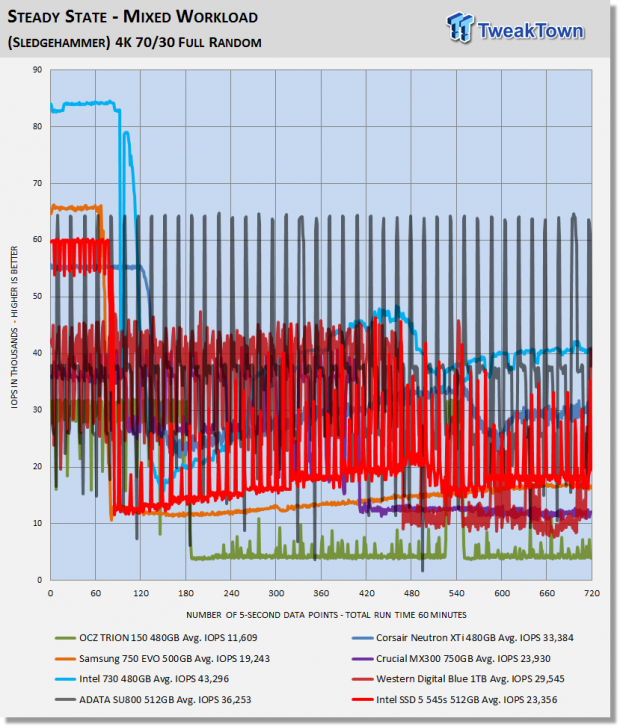
What we like about this test is that it reflects reality. Everything lines up, as it should. Consumer drives don't outperform Enterprise-Class SSDs that were designed for enterprise workloads. Consumer drives based on old technology are not outperforming modern Performance-Class SSDs, etc.
OP and capacity have a lot to do with the results of this test. The SSD 545s doesn't light it up like it does with our other testing, but it does beat half of the drives in our test pool including Samsung's 750 EVO.
Sustained Sequential Write
Version and / or Patch Used: Iometer 2014
Heavy Workload Model
We write to the drive for 1 hour with 128K sequential writes at QD32. We log and chart megabytes per second data at 5-second intervals for 1 hour (720 data points). 60 data points = 5 minutes.
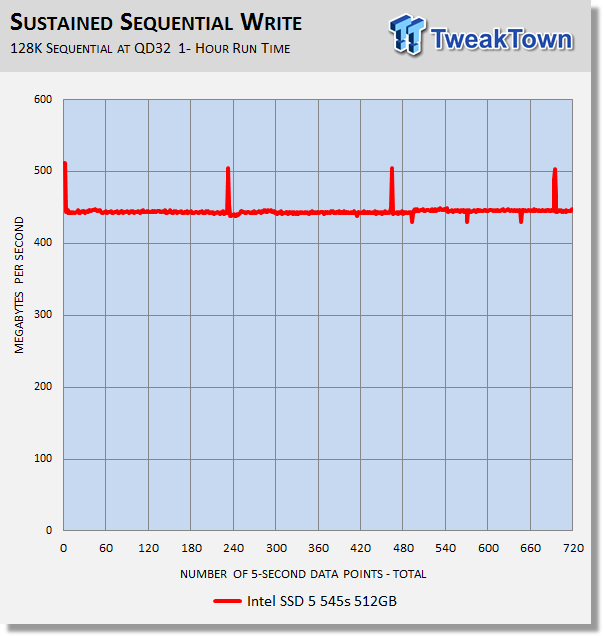
An hour is more than enough time to fill the drive twice, and we averaged 444 MB/s for the entire hour.
Maxed-Out Performance (MOP)
This testing is just to see what the drive is capable of in an FOB (Fresh Out of Box) state under optimal conditions. We are utilizing empty volumes of Windows 10 and Windows Server 2008 R2 64-bit for this testing.
Windows 10 MOP
Intel SSD 5 545s 512GB SATA III SSD
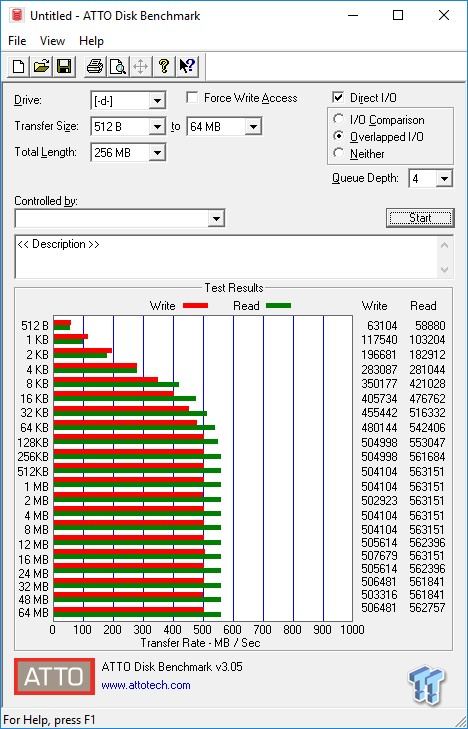
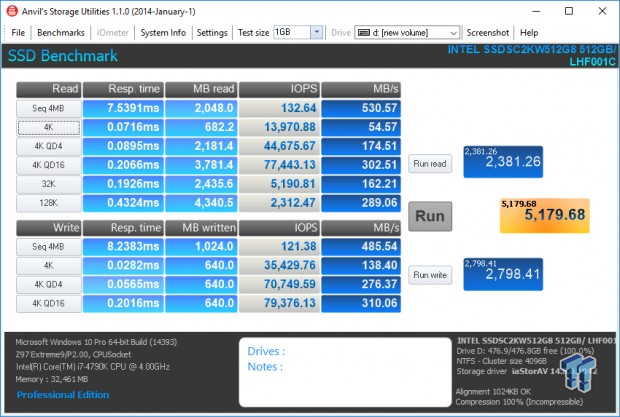
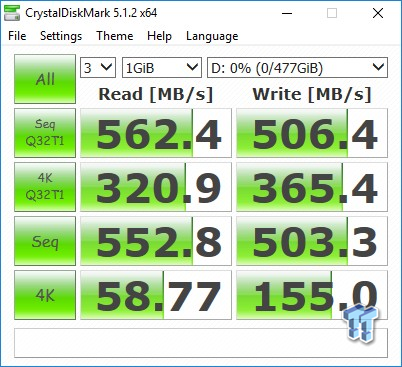
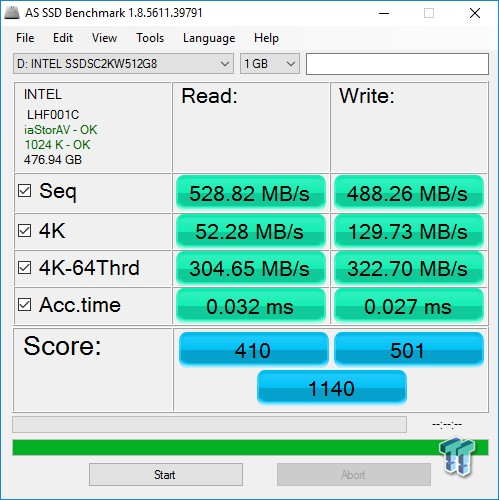
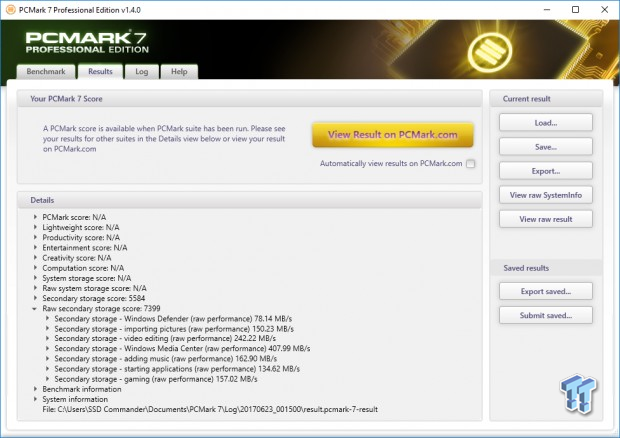
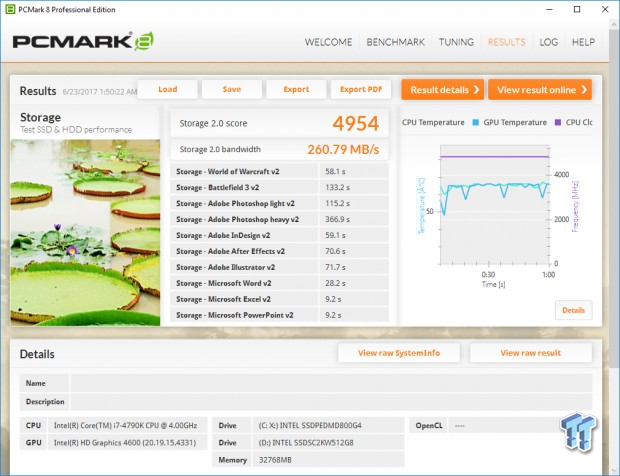
Windows Server 2008 R2 MOP
Intel SSD 5 545s 512GB SATA III SSD
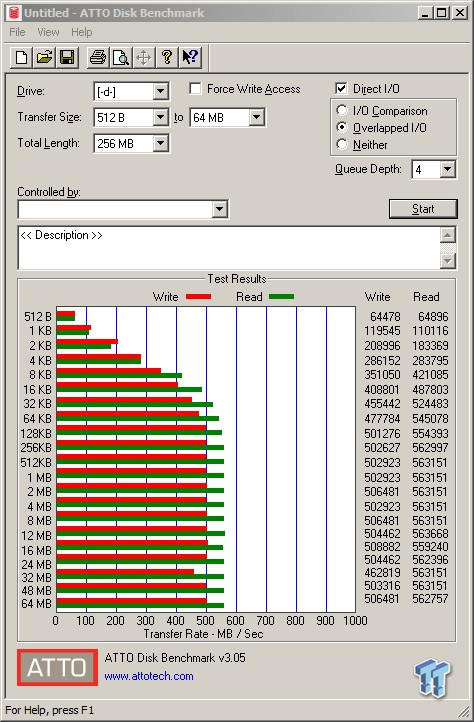
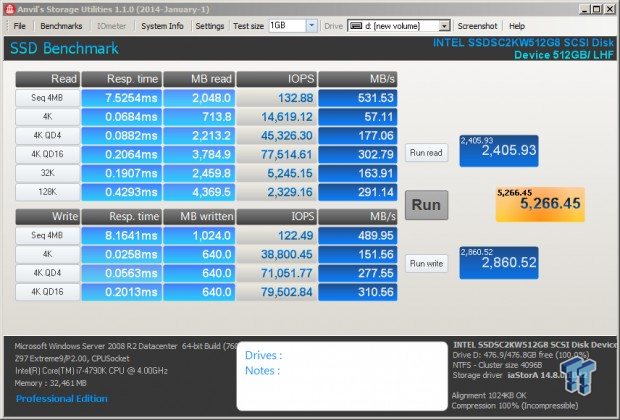
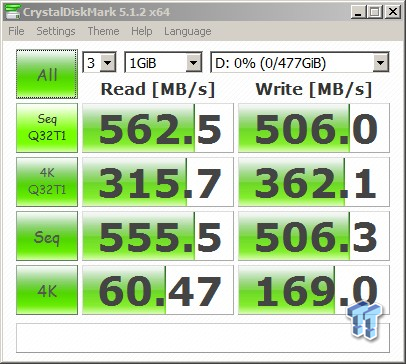
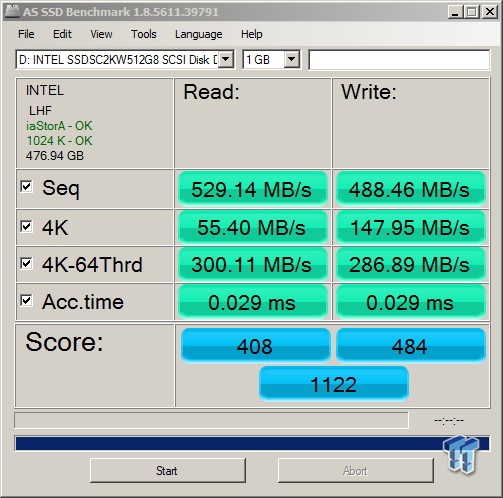
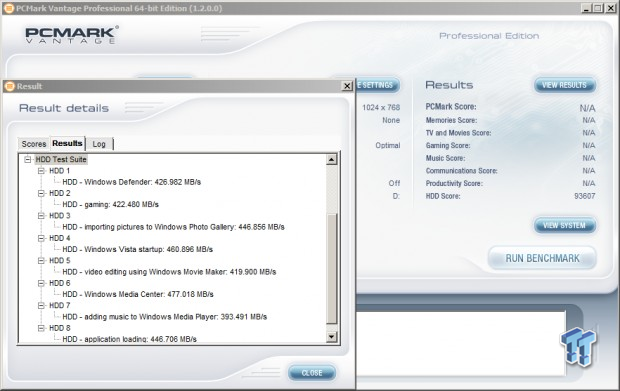
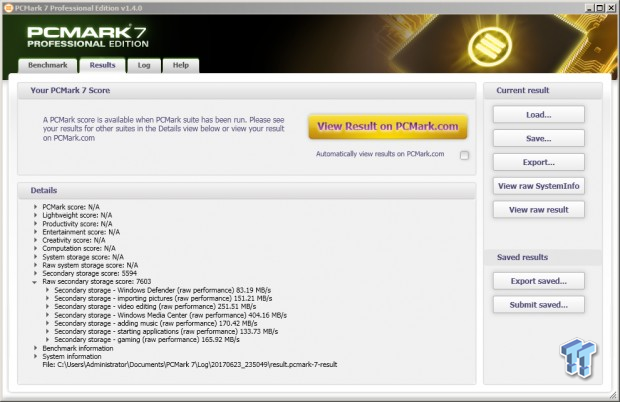
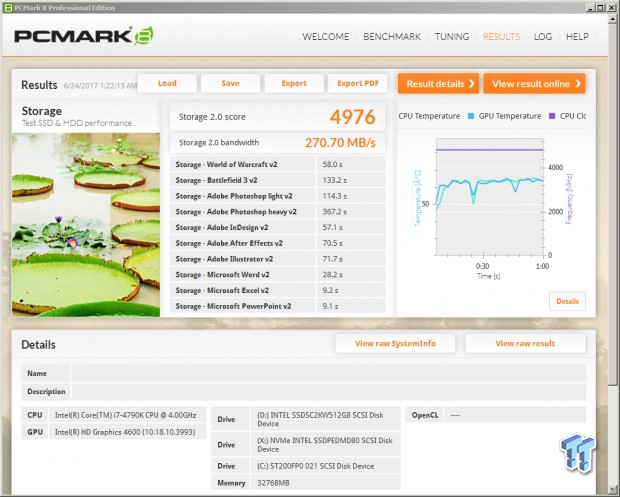
Final Thoughts
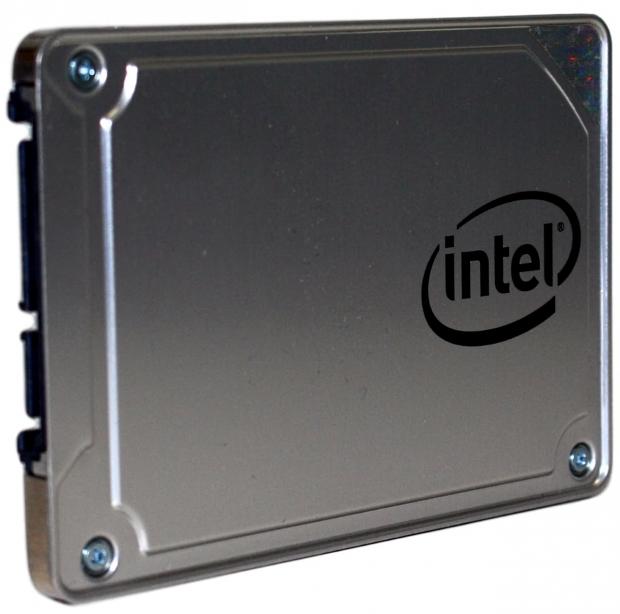
Even though the Intel SSD 5 545s doesn't show us the true potential of Intel's second generation 64-layer 3D flash, it does give us a taste of what is to come; and it tastes good. The Intel SSD 5 545s is one of the best performing SATA SSDs we've ever tested. The reason we are of this opinion comes down to the most important performance metric - random read performance at low queue depths. In this regard, the SSD 545s is a cut above the competition as shown by our Anvil's testing. Whenever a SATA based SSD delivers random performance of over 10,000 IOPS at 4K QD1 read, it is indeed something special. The 545s cranked out an earth shattering 13,800 IOPS at QD1 and additionally delivered the best random read performance we've ever seen from a SATA SSD at QD1-4 when testing with Anvil's.
Of course, this stellar low QD random read performance translates to awesome workload performance. The 545s delivered the goods in our Vantage testing and again in our PCMark 7 testing with massive performance improvements over the drives in our test pool that are running on first-generation IMFT 3D flash.
With the introduction of 64-layer TLC flash, the days of planar flash and MLC flash are quickly coming to an end. 64-layer TLC flash is set to dominate the consumer SSD landscape for the foreseeable future because it promises lower cost, higher capacity, higher endurance and yes, better performance than anything to date.
The SSD 5 545s doesn't have Samsung running for the hills just yet, but the SSD 5 545s wasn't intended to be an EVO killer; just better than most and more affordable. In this regard, the SSD 5 545s hit its intended target. With an opening MSRP of $179.00 and legendary Intel quality, we see the potential that it may give Samsung something to worry about in the near future.
User Experience: In the end, it all comes down to user experience. The SSD 5 545s boots like lightning, launches programs in the blink of an eye and most of all provides consistent performance that is seemingly unaffected by normal consumer workloads that can bring lesser TLC SSDs to their knees. The SSD 5 545s delivers a true tier-one SSD experience that is sure to please, which is why it is TweakTown recommended.
Pros:
- Overall Performance
- Build Quality
- Low QD Random Read
Cons:
- Random Write

| Performance | 95% |
| Quality | 90% |
| Features | 95% |
| Value | 95% |
| Overall | 94% |
The Bottom Line: Put the Intel SSD 545s on your short list because it is one of the best SATA SSDs on the market.
PRICING: You can find products similar to this one for sale below.
 United
States: Find other tech and computer products like this
over at Amazon.com
United
States: Find other tech and computer products like this
over at Amazon.com
 United
Kingdom: Find other tech and computer products like this
over at Amazon.co.uk
United
Kingdom: Find other tech and computer products like this
over at Amazon.co.uk
 Australia:
Find other tech and computer products like this over at Amazon.com.au
Australia:
Find other tech and computer products like this over at Amazon.com.au
 Canada:
Find other tech and computer products like this over at Amazon.ca
Canada:
Find other tech and computer products like this over at Amazon.ca
 Deutschland:
Finde andere Technik- und Computerprodukte wie dieses auf Amazon.de
Deutschland:
Finde andere Technik- und Computerprodukte wie dieses auf Amazon.de
What's in Jon's PC?
- CPU: AMD Ryzen 7800X 3D
- MOTHERBOARD: GIGABYTE AORUS Master X670E
- RAM: Kingston Fury Renegade 7200MHz 32GB
- GPU: ZOTAC AMP Extreme GeForce RTX 4090
- SSD: Crucial T700 2TB Gen5
- OS: Windows 11 Pro
- COOLER: Lian Li Galahad 360 AIO
- CASE: Lian Li Lancool III
- KEYBOARD: Corsair K65 RGB Mini
- MOUSE: SteelSeries AEROX 5 Wireless
- MONITOR: ASUS ROG Strix PG27AQN 360Hz 1440p ULMB2
Similar Content
Related Tags

